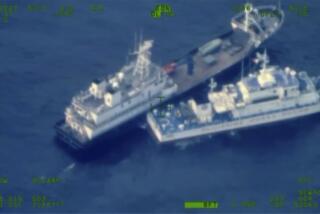U.S. Role in Philippines
- Share via
As a Filipino, I agree with Benedict J. Tria Kerkvliet’s analysis about the current situation in the Philippines as presented in his article (Editorial Pages, Dec. 4), “America Should Adopt Hands-Off Policy in Philippines.”
Short of sending in the U.S. Marines, the United States has very limited leverage with President Ferdinand Marcos. However, as Kerkvliet has suggested, the United States ought to exercise the limited options it has, such as stopping the flow of arms and whatever limited economic aid it has been giving to the Philippines.
The rationale behind this is quite simple: Most of the aid does not get to the ordinary foot soldier or to the common civilian anyway, so there is no real loss as far as the country is concerned. No one is sure what happens to most of the aid, but the number of Park Avenue co-ops, Florida condos, Beverly Hills homes, and banks purchased by members of the Philippine power structure could be an indication.
The situation in the Philippines today is not much different from the upheavals experienced by the United States (the War Between the States), Spain (the Civil War), China (another civil war), and other countries that had to go through similar processes. It seems that countries are just like people: each one of them has to go through a period of adjustment and change so they can get on with their lives. Some make it and some don’t.
Whatever happens in my native country between now and the inevitable fall of the Marcos regime, I am confident that the level-headedness and aversion to violence that most of my countrymen have will prevail. This doesn’t mean that no blood will be shed, however, for Filipinos can meet force with force also, as they did with the Spanish colonial government in 1896 and the United States from 1898 to 1903. We only hope that no other outside power will aid one or more of the factions contending for power.
The shape and form of the post-Marcos government will be difficult to predict as of now. It could range from a military junta (a majority of the field officers are dissatisfied with the present setup) to a transitionary coalition with leftist and rightist elements cooperating to save the country. I don’t believe that the guerrillas, with 16,000 armed troops, can exert a real influence (despite the assessment of the CIA) because the country has more than 7,000 islands and the military has the overwhelming number (300,000) and the mobility.
The U.S. bases might be in danger, but life will go on for most of the Filipinos. If the 70% who are poor today can share in the wealth of the country, that will be worth the sacrifices needed to achieve it.
E. VILLARIN CORAZO
Granada Hills
More to Read
Sign up for Essential California
The most important California stories and recommendations in your inbox every morning.
You may occasionally receive promotional content from the Los Angeles Times.













